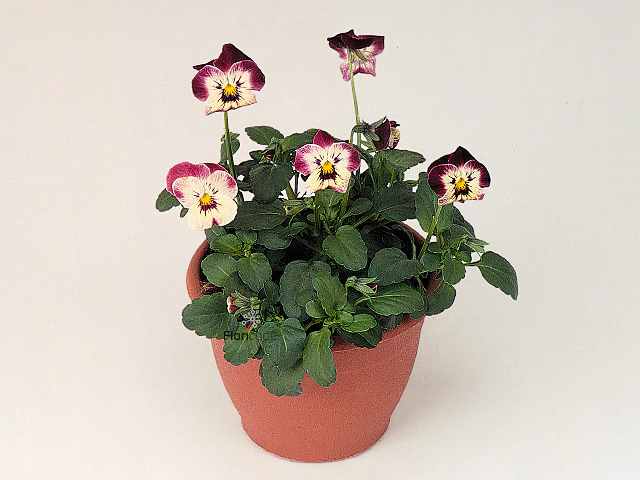Viola (Cornuta Grp) 'Valentine'

| Leaf tip | Emarginate |
| Flower type | Single |
| Leaf margin | Erose |
| Flower scent | Unscented |
| Flower color | Red-dark purple red-059A; Yellow-light yellow-002D |
| Leaf, general shape | Ovate (egg-shaped) |
| Flower diameter | 2,5 - 3 cm; 3 - 3,5 cm |
| Inflorescence | Single-flowered |
| Leaf size | 3 - 4 cm; 2 - 3 cm |
| soil pH requirement | Neutral (pH 6,5 - 7,5) |
| Light conditions | Sunny; Semi-shades |
| Leaf, main color | Medium green |
| Leaf colour, pattern | Unicolored |
| Flower color distribution | Margin; Striate; Bicolored |
| Flower, secondary color(s) | Purple-dark violet-079A; Yellow-dark yellow-014A |
| Moisture requirements | Well-drained; Moist |
| Soil type | Humus rich |
The Viola (Cornuta Grp) 'Valentine', also known as the Valentine Violet, is a stunning flower with a unique combination of qualities. Its appearance and characteristics make it a popular choice among gardeners and flower enthusiasts.
One of the notable features of the Valentine Violet is its leaf tip, which is emarginate. This means that the tip of the leaf has a slight notch or indentation. The flower type is single, with a single layer of petals that form a beautiful and delicate blossom.
The leaf margin of the Valentine Violet is erose, which means that the leaf edge is slightly toothed or jagged. This adds to the overall aesthetic appeal of the plant. Additionally, the flower of the Valentine Violet is unscented, which may be a preference for those who are sensitive to strong floral fragrances.
The flower color of the Valentine Violet varies, with shades ranging from a deep purple-red to a light yellow. The red-dark purple-red hue is labeled as 059A, while the yellow-light yellow shade is identified as 002D. The color distribution of the flower is also captivating, with a margin, striate, and bicolored pattern. This means that the petals may have multiple colors and markings, creating a visually striking display.
The Valentine Violet has an ovate, or egg-shaped, leaf structure. The flower diameter ranges from 2.5 to 3 cm or 3 to 3.5 cm, showcasing a sizable and eye-catching bloom. The inflorescence is single-flowered, with one flower per stem.
In terms of size, the Valentine Violet has leaves that measure between 3 and 4 cm in length and 2 and 3 cm in width. The main color of the leaf is a medium green shade, providing a lovely contrast to the vibrant flower colors. The leaf color pattern is unicolored, meaning it has a consistent hue throughout.
When it comes to cultivating the Valentine Violet, it thrives in neutral soil with a pH range of 6.5 to 7.5. It can tolerate a variety of light conditions, including both sunny areas and semi-shaded locations. As for moisture requirements, the Valentine Violet prefers well-drained soil but can also tolerate moist conditions. It thrives in humus-rich soil, which provides the necessary nutrients for healthy growth.
Overall, the Valentine Violet is a versatile and beautiful flower with a range of appealing characteristics. Its stunning flower colors, unique leaf features, and ability to adapt to various growing conditions make it an excellent choice for any garden or floral arrangement. Whether planted as a standalone specimen or combined with other flowers, the Valentine Violet is sure to add a touch of elegance and charm to any space.
Market availability index by month:
| Jan. | Feb. | Mar. | Apr. | May | Jun. | Jul. | Aug. | Sep. | Oct. | Nov. | Dec. |
|---|---|---|---|---|---|---|---|---|---|---|---|
| - | - | 4 | - | - | - | - | - | - | - | 1 | - |